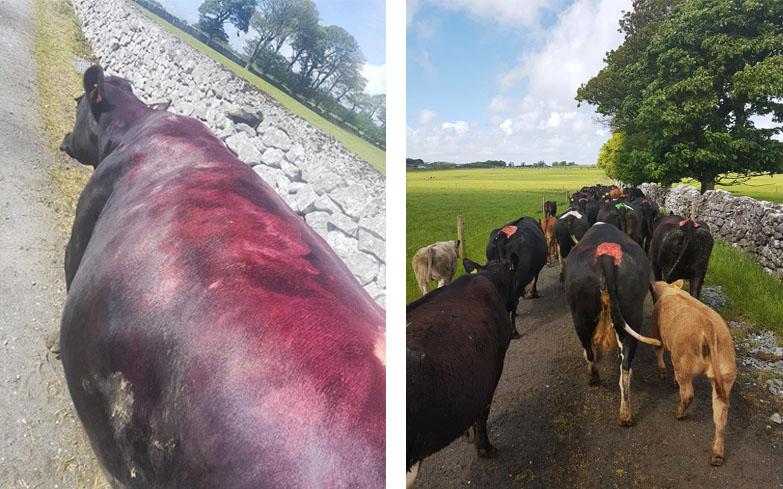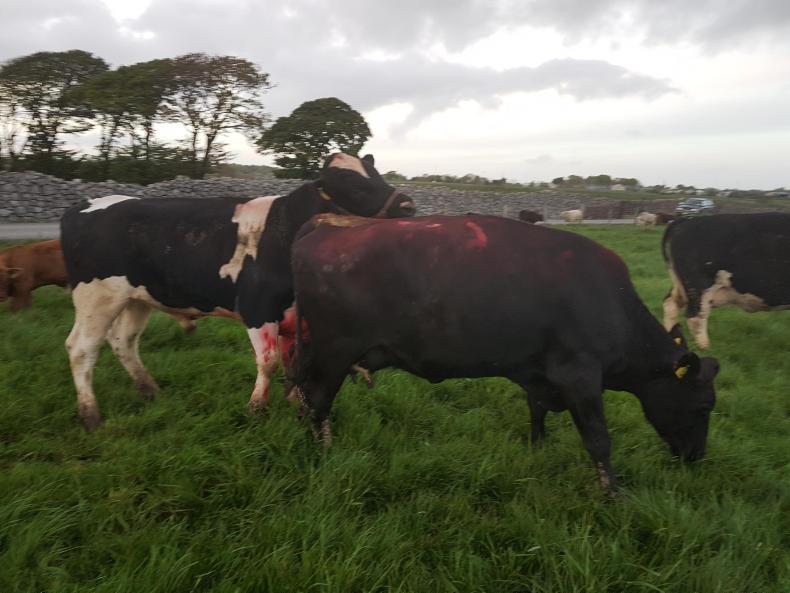Newford Farm has endured a difficult spring, with significant challenges still being faced in grazing management. The effort invested by farm manager Matthew Murphy in keeping cows outdoors during inclement weather in March and April is now paying dividends in the farm's breeding performance.
Breeding commenced on 23 April and despite what seemed like a slow start, there has been 81 cows artificially inseminated in the first 18 days. This leaves the farm on course to achieve its target submission rate of 90% of herd bred in the first three weeks.
The herd has achieved a conception rate to first service of over 60% in recent years and it is hoped that weather will not have any negative influence on this being repeated in 2018.
Cow groups
Cows are being run in two groups of 50 and 51 and their calves, with a vasectomised bull running with each. Matthew says the use of vasectomised bulls has been one of the major success stories in recent years.
Each bull is fitted with a chin ball and marking fluid and as the bull dismounts a cow, the chin ball leaves a mark. The pictures give a good reflection of its benefits.
The chin ball and harness cost €160, while five litres of marking fluid costs €90. Matthew says that he purchased 10 litres in 2016 and still has some left. Each bull cost €850 and were purchased from a high-health status herd where they underwent an extensive vaccination programme.
Tail paint
Cows are also being tail-painted, with paint reapplied after AI. Explaining the reasoning for using both these heat detection aids, Matthew says that there have been a number of cases where a few cows have been in heat on the same day and the vasectomised bull has taken a liking to some particular cows.

A cow returning to the herd after artificial insemination. The chin ball worked extremely well in identifying this cow in heat. Left: A cow returning to the herd after artificial insemination. The chin ball worked extremely well in identifying this cow in heat. Right: One batch of cows and calves being moved to a new paddock. Calves received their second clostridial disease vaccine last week.
In such instances, the cows that the bull has neglected to rise on have been mounted by the other cows in heat, with the removal of tail paint avoiding these cows being missed. The tail paint costs €21/litre bottle, with in the region of 10 bottles purchased over a season.
Inseminated
As previously touched on, cows are inseminated once daily around noon. Any cow that is in heat in the previous evening and morning of AI is served. Cows that are still showing heat activity that evening are inseminated again the following day with AI carried out by Matthew.
The first-cross cows suit the 100% AI system, with Matthew generally able to use strip wires to remove cows in heat, which can then be walked to the yard. This greatly cuts down on the labour and disruption of bringing large numbers to the yard.
Vaccination
The other main task carried out this week was administering calves with their second clostridial disease vaccination.
Table 1 details the sires selected in 2018 and the selection process for matching sires to particular cows.
Read more
Grass+: Not out of the woods yet
Good-quality cattle firm but plainer stock slower to sell
Newford Farm has endured a difficult spring, with significant challenges still being faced in grazing management. The effort invested by farm manager Matthew Murphy in keeping cows outdoors during inclement weather in March and April is now paying dividends in the farm's breeding performance.
Breeding commenced on 23 April and despite what seemed like a slow start, there has been 81 cows artificially inseminated in the first 18 days. This leaves the farm on course to achieve its target submission rate of 90% of herd bred in the first three weeks.
The herd has achieved a conception rate to first service of over 60% in recent years and it is hoped that weather will not have any negative influence on this being repeated in 2018.
Cow groups
Cows are being run in two groups of 50 and 51 and their calves, with a vasectomised bull running with each. Matthew says the use of vasectomised bulls has been one of the major success stories in recent years.
Each bull is fitted with a chin ball and marking fluid and as the bull dismounts a cow, the chin ball leaves a mark. The pictures give a good reflection of its benefits.
The chin ball and harness cost €160, while five litres of marking fluid costs €90. Matthew says that he purchased 10 litres in 2016 and still has some left. Each bull cost €850 and were purchased from a high-health status herd where they underwent an extensive vaccination programme.
Tail paint
Cows are also being tail-painted, with paint reapplied after AI. Explaining the reasoning for using both these heat detection aids, Matthew says that there have been a number of cases where a few cows have been in heat on the same day and the vasectomised bull has taken a liking to some particular cows.

A cow returning to the herd after artificial insemination. The chin ball worked extremely well in identifying this cow in heat. Left: A cow returning to the herd after artificial insemination. The chin ball worked extremely well in identifying this cow in heat. Right: One batch of cows and calves being moved to a new paddock. Calves received their second clostridial disease vaccine last week.
In such instances, the cows that the bull has neglected to rise on have been mounted by the other cows in heat, with the removal of tail paint avoiding these cows being missed. The tail paint costs €21/litre bottle, with in the region of 10 bottles purchased over a season.
Inseminated
As previously touched on, cows are inseminated once daily around noon. Any cow that is in heat in the previous evening and morning of AI is served. Cows that are still showing heat activity that evening are inseminated again the following day with AI carried out by Matthew.
The first-cross cows suit the 100% AI system, with Matthew generally able to use strip wires to remove cows in heat, which can then be walked to the yard. This greatly cuts down on the labour and disruption of bringing large numbers to the yard.
Vaccination
The other main task carried out this week was administering calves with their second clostridial disease vaccination.
Table 1 details the sires selected in 2018 and the selection process for matching sires to particular cows.
Read more
Grass+: Not out of the woods yet
Good-quality cattle firm but plainer stock slower to sell







 This is a subscriber-only article
This is a subscriber-only article










SHARING OPTIONS: